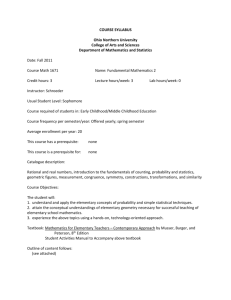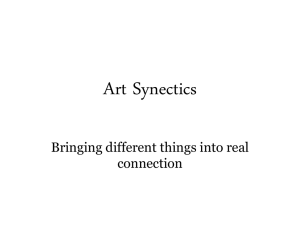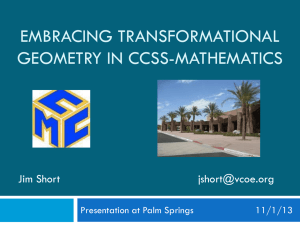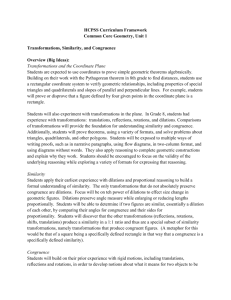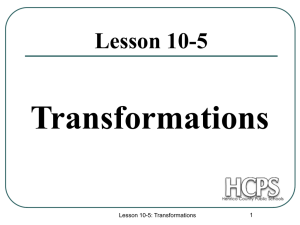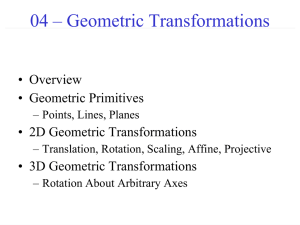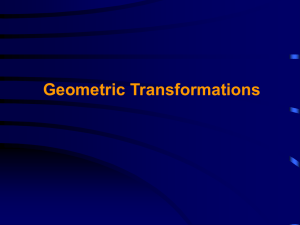Understanding Geometric Transformations
advertisement
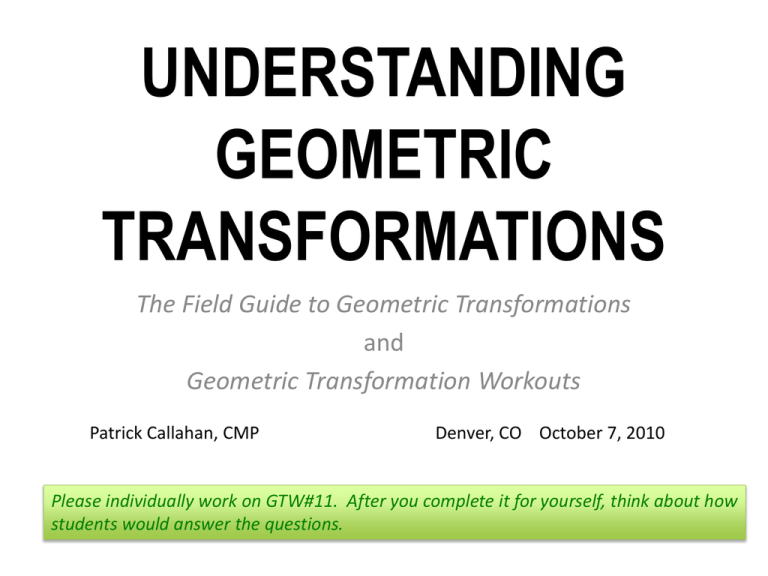
UNDERSTANDING GEOMETRIC TRANSFORMATIONS The Field Guide to Geometric Transformations and Geometric Transformation Workouts Patrick Callahan, CMP Denver, CO October 7, 2010 Please individually work on GTW#11. After you complete it for yourself, think about how students would answer the questions. Learning and Teaching Geometry Project Overview • In year four of a 5-year National Science Foundation project • Developing videocase-based, PD materials – 1 Foundation Module – 4 Extension Modules • Staff: Nanette Seago (PI), Mark Driscoll (Co-PI), Jennifer Jacobs, Johannah Nikula, Patrick Callahan, Hilda Borko • Advisory Board:Harold Asturias, Tom Banchoff, Phil Daro, Megan Franke, Karen Koellner, Glenda Lappan, Hung-Hsi Wu • Evaluation Team: [Horizon Research, Inc.] Dan Heck, Kristen Malzahn, Courtney Nelson Plan for this hour • • • • • A little background We will introduce the GTWs and Field Guide Explore sample items Analyze the design and use of these tools Look at some video clips of students using the GTWs Background • The focus of the LTG project is on developing a robust understanding of similarity via a dynamic definition of similarity (i.e. in terms of geometric transformations) • After the first year of the project we discovered that most students (and many teachers) did not have experience with geometric transformations. Background To remedy this situation, inspired by work of Franke and others on Highly Leveraged Practices like “number talk,” we designed some tools that could be used without requiring much time nor be heavily dependent on curriculum or pacing guides. These became the Geometric Transformation Workouts. Background Then it became clear that the GTWs themselves needed more support. So, inspired by the laminated fish identification guides you can use while snorkeling, we created the Field Guide to Geometric Transformations. Evidence of Understanding There is no single piece of evidence that can “prove” understanding. Rather, one builds a case for understanding via a preponderance of evidence. The GTWs are a tool for -eliciting evidence of understanding of geometric transformations -providing experience and feedback for students to develop a robust understanding of geometric transformations -providing opportunities to make visible a variety of types of evidence of student understanding of geometric transformations Types of Evidence of Understanding Here are some examples for understanding translations (not in any specific order): Design Principles For GTWs These are designed to be “workouts” in the sense that they are not meant to introduce new concepts, but rather allow for practice and refinement around the ideas, definitions and language of geometric transformations. These workouts are designed for students to work individually on them for a short time and then have a teacher led discussion with the class. The questions are often multiple choice or simple drawings. They are generally straightforward questions and are not meant to be lengthy explorations. The following format is suggested: o Students work individually for 5 minutes on the GTW o Teacher leads whole class discussion for 5-10 minutes FAQ: Is it OK to use these in other ways? A: Yes! We are still exploring what works. Using the GTWs • The primary goal is to elicit evidence of understanding and develop robust definitions and language around geometric transformations. • A secondary goal is to provide experiences working with these transformations emphasizing the visual and dynamic aspects of the transformations. Just determining who got the correct answer, or asking for explanations without discussion or comment is not the designed use of these tools. Exploring the GTWs • Discuss the items from GTW#11 (focus on evidence of understanding!) NAEP item examples… The 2007 8th grade NAEP item below was classified as “Use similarity of right triangles to solve the problem.” Does a Dynamic Approach Help? The 2007 8th grade NAEP item below was classified as “Use similarity of right triangles to solve the problem.” Only 1% of students answered this item correctly. The 1992 12th grade NAEP item below was classified as “Find the side length given similar triangles.” Only 24% of high school seniors answered this item correctly. The 1992 12th grade NAEP item below was classified as “Find the side length given similar triangles.” 8 A rotation and a dilation show the corresponding sides of the similar triangles. 5 6 8 5 6 8 x 12.8 Fig ure A Fig ure B Only 24% of high school seniors answered this item correctly. Common Core Standards Here is an excerpt from the new Common Core Standards for 7th Grade Mathematics: 1. Verify experimentally the fact that a rigid motion (a sequence of rotations, reflections, and translations) preserves distance and angle, e.g., by using physical models, transparencies, or dynamic geometry software: (a) Lines are taken to lines, and line segments to line segments of the same length. (b) Angles are taken to angles of the same measure. (c) Parallel lines are taken to parallel lines. 2. Understand the meaning of congruence: a plane figure is congruent to another if the second can be obtained from the first by a rigid motion. 3. Verify experimentally that a dilation with scale factor k preserves lines and angle measure, but takes a line segment of length L to a line segment of length kL. 4. Understand the meaning of similarity: a plane figure is similar to another if the second can be obtained from the first by a similarity transformation (a rigid motion followed by a dilation). The basic geometric transformations • • • • Translations Reflections Rotations Dilations • Congruence • Similarity The Field Guide to Geometric Transformations • • • Look at the Field Guide Consider the design features (note: your copies are B&W, color is an important part of the design) Learn tools, techniques, and activities to elicit, document and analyze student understanding of the mathematics. 1. Watch a video clip 2. BEFORE discussing: each person write down at least one specific piece of evidence of understanding. 3. Discuss/analyze the evidence with small group CLIPS: Abby: vid005, 2:30 - end Will: vid018, 4:31 - end Dominick: vid007, 11:05-12:50, (plus last 10sec) Looking at some student data 1. Which of these shows a pair of figures equivalent by a rotation of the square? a b c d Looking at some student data 1. Which of these shows a pair of figures equivalent by a rotation of the square? a 2% b 86% 16% c 0% d More student data 2. Which of these pictures shows two objects equivalent by a reflection in the dotted line? a b c 3. Are these two figures are equivalent by the following nontrivial transformations? Mark YES or NO for each. YES or NO: Translation YES or NO: Reflection YES or NO: Rotation YES or NO: Dilation d More student data 2. Which of these pictures shows two objects equivalent by a reflection in the dotted line? 27% 6% 55% 2% a b c 3. Are these two figures are equivalent by the following nontrivial transformations? Mark YES or NO for each. YES or NO: Translation YES or NO: Reflection YES or NO: Rotation YES or NO: Dilation 29%, 80%, 57%, 29%, d 71% 20% 43% 69% More student data 4. The same trans lation that translates triangle P to triangle Q would translate square X to which square? a P b X Q d e c More student data 4. The same trans lation that translates triangle P to triangle Q would translate square X to which square? 8% a P b 22% X Q 35% c d e 16% 6% Next steps
